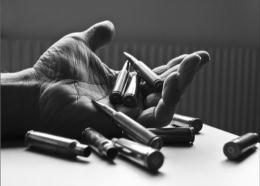

 The Accurate Reloading Forums
The Accurate Reloading Forums  THE ACCURATE RELOADING.COM FORUMS
THE ACCURATE RELOADING.COM FORUMS  Rifles
Rifles  Small Calibers
Small Calibers  Springfield-Enfields shooting low
Springfield-Enfields shooting lowGo  | New  | Find  | Notify  | Tools  | Reply  |  |
| one of us |
My shooting buddy has two pristine 30-06 rifles, a Springfield and an Enfield. Both are accurate considering they are battle rifles and got a few years on them. The Springfield is an 03A3 made by Remington in 1943, the Enfield was made by Eddystone in 1918. Both rifles look to be new. My buddy has been shooting the surplus 150 something grain ammo in both rifles and it consistently shot low at 100 yards, with the sites set at their lowest setting, 200 yards. I suggested that he find some of the 175 - 180 grain ammo, as that was the was the bullet weight at that time. He found some 175 grain Lake City Match. Both rifles shoot low with the Match Ammo, the Springfield shoots 10 inches low and the Enfield shoots 4 inches low, 100 yards. Both rifles cluster the bullets in a tight group, low and a little bit to the left. The windage we can deal with, but the elevation has us stumped. We are both curious how the armory would correct this problem. I�m guessing that we could file the front site down a bit or find a new lower front site. He�s reluctant to do much remodeling as the rifles have matching serial numbers and are pristine. He is about to set up and start reloading for these two rifles, and he�d like some suggestions. What would be a good bullet to use and what powders would be good for use in these two old veterans. I�m remembering that IMR 3031, IMR4064 and IMR 4895 were recommended for the 30-06. Any help sure would be appreciated | ||
|
| one of us |
From what I can remember, battle rifles where designed with intent to shoot at objects ranging from 300 yds to 500 yds. Hatchers Notebook, I think, which is an excellent source for Springfield Rifles. Gennerally speaking, in reloading, a faster lighter bullet will have a higher point of impact at 100 yds. Faster means straighter. A heavier bullet traveling at a slower speed will have more drop at 100 yards. You did not say what type of bullet combination you where looking for, you could try anything from a 100g Plinker by Speer, or a 125g Sierra HP. The latter of which I have had great fun with out of my father's Springfield 03 using Win 760 ball powder. First try a lighter bullet to bring the impact up, before you try modifying the rifles. Standard bullet weight for WWII was 150g FMJ. Goodluck, and have fun. I hope this helps. Wish I had one of each. Big 17 [This message has been edited by Big 17 (edited 02-20-2002).] | |||
|
| one of us |
I thank you for your reply. I think my experience comes up with the opposite of the light bullet/higher velocity equals higher on the target. The lighter bullet, 150 grain shot lower on the target then the heavier bullet. It's my guess that this is the result of the rifle recoiling and the slower bullet having more time in the barrel, hence the muzzle of the rifle is pointed a bit higher when the bullet exits. Does any one happen to know the rifling twist of the Springfield and Enfield? Jim | |||
|
| one of us |
Your rifle does not recoil while the bullet is in the barrel. It start recoiling the instant the bullet leaves the barrel. To find out what the twist rate is do a simple test, take a cleaning rod, put a tight fitting patch on the end. Put a mark on the rod at the muzzle, another mark so that you can tell when the rod has gone one complete turn. Push the rod down the barrel until it goes around one turn, make another mark at that point. Remove the rod and measure the distance between the two marks at the muzzle. That distance is rate of twist for one inch. It probably is 10". Good luck Big 17 | |||
|
| Powered by Social Strata |
| Please Wait. Your request is being processed... |
|
 The Accurate Reloading Forums
The Accurate Reloading Forums  THE ACCURATE RELOADING.COM FORUMS
THE ACCURATE RELOADING.COM FORUMS  Rifles
Rifles  Small Calibers
Small Calibers  Springfield-Enfields shooting low
Springfield-Enfields shooting low

Visit our on-line store for AR Memorabilia

